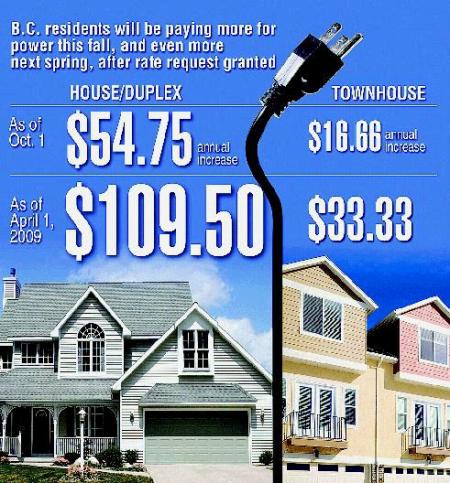Billing structure that takes effect next month designed to cut power use
Scott Simpson
Sun

Photograph by : Roger Watanabe, Vancouver Sun
Ready or not, BC Hydro residential customers will see their electricity bills in a whole new light next month.
The B.C. Utilities Commission has granted Hydro’s application to bill residential customers on the basis of a new, two-tiered rate system that will reward people who conserve electricity, and impose higher costs on those who don’t.
Hydro customers using more than 1,350 kilowatt hours in a two-month billing period will be charged the higher rate for the portion of their power over this amount.
Based on historic average consumption, consumers living in single-family homes, duplexes and condos will pay at least a portion of their power at the higher rate, while apartment owners will stay comfortably within the lower rate due to substantially lower average consumption.
The new system will be phased in over six months, beginning with one rate bump on Oct. 1, and another on April 1, 2009.
The Utilities Commission suggests Hydro prices Tier 1 power at about 6.15 cents per kilowatt hour. Tier 2 power will be 7.21 cents per kwh in October, jumping to 8.27 cents per kwh next April.
For an average BC Hydro customer living in a single-family home, duplex, or condo, the difference between the cost of Tier 1 and Tier 2 power will work out to about $5 more per month starting in October, rising to $10 a month starting in April 2009.
The intent of the change is that customers will seek to avoid the higher rates by changing their behaviour to cut back power use.
Hydro filed an application to change its rate structure in February, and final arguments on the application were still being heard as recently as mid-August.
Hydro already has approval from the BCUC for a 13-per-cent rate increase through 2009, and says most customers should save money on the two-tier rate compared to applying the same flat rate to everybody.
In Hydro’s application, it recommended a tier-one threshold high enough to encompass single family homes and duplexes while allowing condo owners and apartment dwellers to escape exposure to the higher tier-two rates.
However, the commission modified Hydro’s recommendations, lowering the tier-one threshold almost 20 per cent.
Hydro had initially proposed a tier-one threshold of 1,600 kilowatt hours per two-month billing period. BCUC lowered that to 1,350 kilowatt hours.
As a result, condo owners will now pay the higher tier-two rate on a portion of their power, according to BC Hydro stats for annual electricity use by residential account type.
Hydro had also proposed a more gradual introduction of the tier-two rate, with the spread between tier one and tier two widening over time.
BC Public Interest Advocacy Centre executive director Jim Quail said in an interview he’s concerned by how quickly the commission and Hydro are moving to bring the new rates into effect, noting that Terasen Gas got almost two years to prepare consumers for the introduction of third-party gas marketers.
Quail thinks the new system suits the provincial government’s green-power agenda more than it suits actual consumers.
“Pretty clearly the timing wasn’t driven by anything that makes sense, but almost entirely by politics,” Quail said.
A spokesman for a Vancouver Island group took a more favourable view.
Ludo Bertsch of Energy Solutions for Vancouver Island applauded BCUC’s decision to freeze the tier-two rate rather than accept Hydro’s recommendation to allow the spread to widen over time.
Bertsch said the commission’s decision to spread the cost of the program among more people was balanced because it would encourage a greater number of Hydro customers to conserve.
“Seventy per cent of our customers are better off with a two-step conservation rate than they would be if we just had that flat [13-per-cent] rate increase [over two years],” BC Hydro spokeswoman Susan Danard said.
“Most people, if they take a few basic steps, honestly, they can reduce the bill impact so that they end up paying less than last year — just by doing a few things like powering down the computer and turning the heat down at night or when you are not at home, or installing a programmable thermostat.”
© The Vancouver Sun 2008

